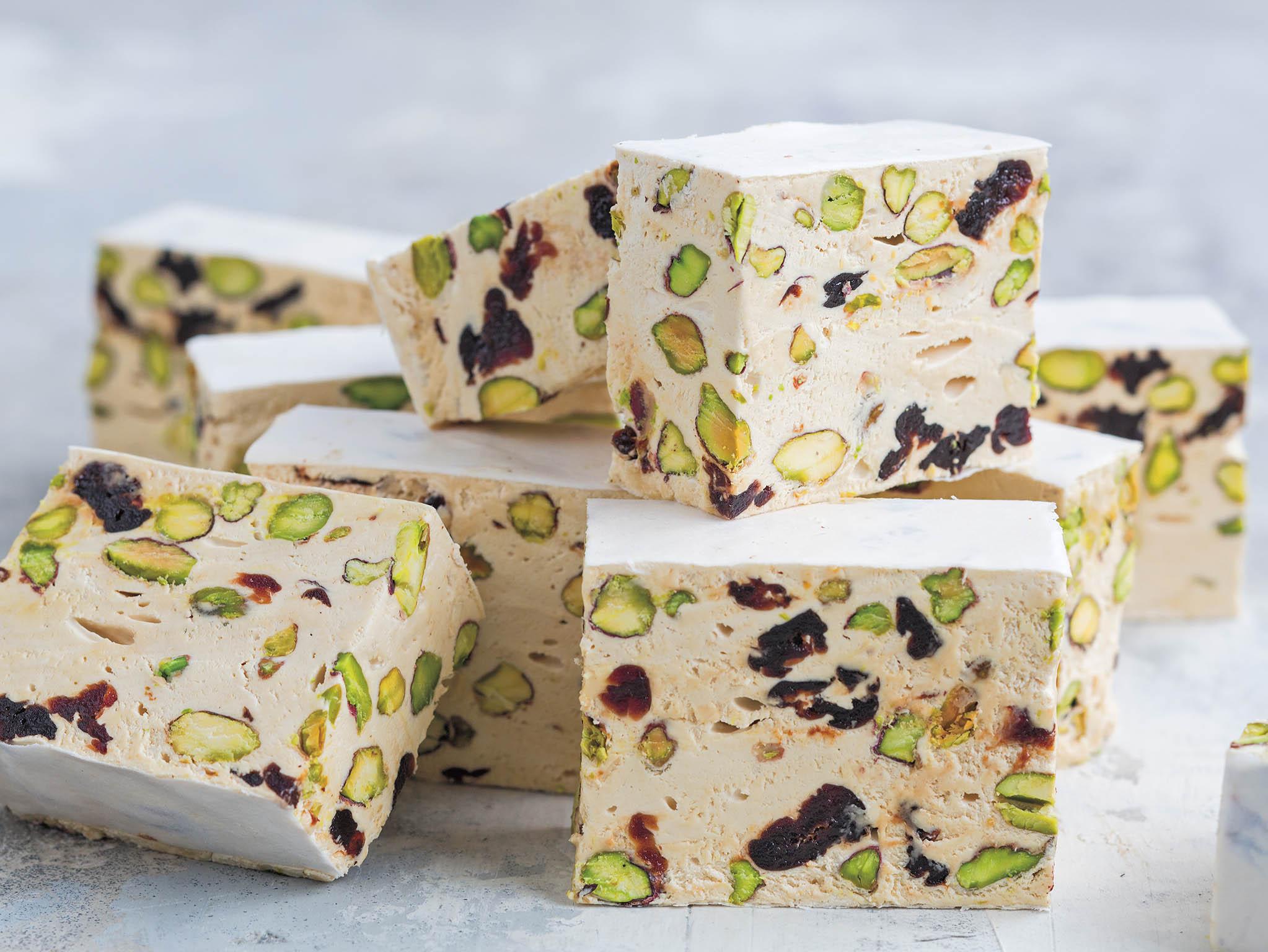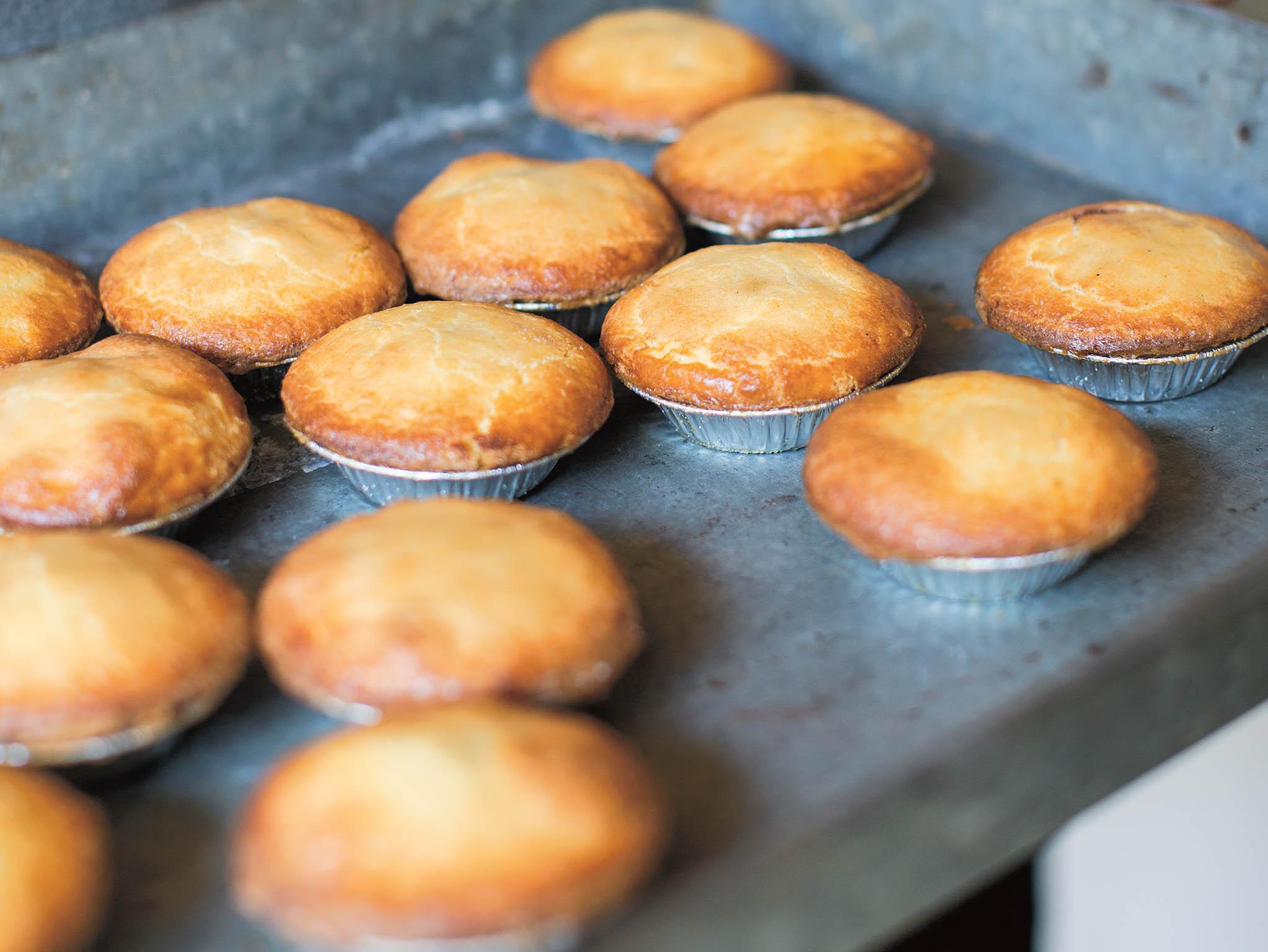Three Christmas recipes from The Tivoli Road Baker
From luxury treats for the adults to fun – and messy – projects for the kids, there’s something for everyone in Michael James's new book

Your support helps us to tell the story
From reproductive rights to climate change to Big Tech, The Independent is on the ground when the story is developing. Whether it's investigating the financials of Elon Musk's pro-Trump PAC or producing our latest documentary, 'The A Word', which shines a light on the American women fighting for reproductive rights, we know how important it is to parse out the facts from the messaging.
At such a critical moment in US history, we need reporters on the ground. Your donation allows us to keep sending journalists to speak to both sides of the story.
The Independent is trusted by Americans across the entire political spectrum. And unlike many other quality news outlets, we choose not to lock Americans out of our reporting and analysis with paywalls. We believe quality journalism should be available to everyone, paid for by those who can afford it.
Your support makes all the difference.Gingerbread
Here’s something for everyone to enjoy at Christmas.
This gingerbread has enough warm spice to make a sophisticated treat for the grown-ups, but not enough to turn the kids off. The kids can get involved in making them, too; cutting out the shapes and icing them can be a lot of fun. The gingerbread will last up to five days in an airtight container, so it makes an excellent gift in the lead-up to Christmas.
Makes 24
Gingerbread
585g plain (all-purpose) flour
pinch ground clove
⅓ nutmeg, freshly grated
1tsp ground cinnamon
2tsp ground ginger
1tsp bicarbonate of soda (baking soda)
½ tsp salt
215g unsalted butter, softened
225g soft brown sugar
185g golden syrup (use honey or maple syrup if unavailable)
3 egg yolks, at room temperature
Icing
1 egg white
250g icing sugar, sifted
½ tsp lemon juice
To make the gingerbread, sift together the flour, spices, bicarbonate of soda and salt in a medium-sized bowl. In a stand mixer fitted with the paddle attachment, cream the butter, sugar and golden syrup until pale but not too aerated. With the mixer still running, add the egg yolks one at a time, beating between each addition until just combined. Add the dry ingredients and mix gently on a low speed, until just combined.
Divide the dough into two pieces and roll each piece out into a disc roughly 2cm (¾ in) thick. Wrap each disc in plastic wrap and refrigerate for one hour, to rest. Remove the dough from the fridge and roll each disc out between two sheets of baking paper into a sheet 5mm (¼ in) thick. Leave them between the sheets of baking paper and return them to the fridge for an hour, to set firm.
Preheat the oven to 170°C (340°F). Remove the biscuit dough from the fridge and lay the sheets out on the bench. Line three trays with baking paper, and cut your shapes out of the dough with cookie cutters, laying them out evenly on the trays and leaving 2cm (¾ in) between each biscuit to ensure an even bake. Bake for six minutes, then turn the trays around and bake for another four to six minutes, until the biscuits are golden brown. Set aside to cool completely before icing.
To make the icing, place the egg white in a medium sized bowl and add the icing sugar one spoonful at a time, whisking lightly to fully incorporate the sugar between each addition. Whisk through the lemon juice, then transfer the icing to a piping (icing) bag fitted with a fine nozzle and decorate your biscuits as you like. The gingerbread is ready to eat once the icing has set.

Pistachio and sour cherry nougat
The dark red cherries and green pistachios set in snow-white nougat make this treat the very image of Christmas. It’s so pretty and festive looking cut into small pieces for your Christmas table, and it makes a beautiful gift simply wrapped in clear cellophane. The sour cherries are a nice counter to the sweetness of the nougat, and the pistachios add texture and nuttiness.
Makes one 24cm (9½ in) square tin
6 rice paper sheets
1725g caster (superfine) sugar
570g glucose syrup
570g honey
250g water
300g white chocolate, roughly chopped
600g whole raw pistachios
420g dried sour cherries
270g egg white (9 egg whites), at room temperature
Bakery notes: Timing is very important with this recipe. You need to have the sugar at the correct temperature just as the egg whites come to a meringue, as well as having the chocolate already melted, and the pistachios and cherries warm. It’s important to have the nuts and cherries warm so they don’t solidify the nougat before you have time to mix them through properly at the end.
Read through the method thoroughly before you start making the nougat – it will make the process smoother. Make the nougat the day before you need it, to allow it to set overnight. Lightly grease the sides and base of the tin, then lay the rice paper over the base, shiny side down, so that the sheets are slightly overlapping (cut to fit if needed). Preheat the oven to 170°C (340°F).
In a large stockpot, mix together the sugar, glucose syrup, honey and water. Place over a high heat and bring it up to 140°C (280°F) on a sugar thermometer. This will take about 20 minutes. Meanwhile, half-fill a saucepan with water and bring to a simmer, then place a metal mixing bowl over it, ensuring that the bowl doesn’t touch the water. Put the white chocolate into the bowl and melt, stirring occasionally to remove any lumps. Be careful not to overheat the white chocolate. Turn off the heat and leave until ready to use. If it starts to set, gently reheat it using the same method.
Spread the pistachios out on a baking tray and bake in the oven for four minutes, until lightly toasted. Add the cherries to the tray and return it to the oven, then turn the oven off and leave the door slightly ajar. This will help keep the pistachios and cherries warm until you’re ready to use them. Place the egg whites in the bowl of a stand mixer fitted with the whisk attachment. Once the sugar syrup reaches 140°C (280°F), start whisking the egg whites on a medium-high speed until a soft, loose meringue starts to form.
By this time your syrup should be at 145°C (290°F). Take it off the heat and, with the whisk still running, pour the syrup slowly into the egg whites in a thin, steady stream, being very careful not to get splattered by the molten sugar. The mixture will increase in volume and become very thick. Turn the mixer down to a low speed and leave it to mix and cool for a few more minutes. Remove the whisk attachment and add the paddle attachment to the mixer.
Mixing on a slow speed, slowly add the melted white chocolate in a thin stream, until totally incorporated. Turn the mixer off, add the nuts and cherries, then turn it back onto a low speed. Mix just until the nuts and cherries are evenly distributed – be careful not to mix for any longer, or the cherries will bruise.
Wearing gloves (this bit gets messy), use a scraper to scoop the nougat out of the bowl into your prepared tray. With wet hands, press the nougat into all the corners of the tin and flatten out the top. Place another layer of rice paper over the top, with the shiny side up, pressing gently to flatten it over the top for a nice even finish. Leave the nougat in a cool dry place to set overnight.
Run a knife around the edge of the tin to loosen the nougat, then invert it over a chopping board, gently pressing the base to release the nougat (it might need a bit of a wiggle). Use a large cook’s knife to trim the edges and cut into your desired portions. The nougat will keep for several months at room temperature in an airtight container. Don’t store it in the fridge, or anywhere too warm.

Mince pies
Mince pies were one of the earliest written British recipes, first documented in the Middle Ages. They originally contained minced meat, offal and suet, made tasty with generous spicing. They have since evolved into a spiced fruit pie traditionally eaten at Christmas time. At Tivoli Road, we make about 140kg (300lb) of fruit mince for our pies, starting in March. We macerate the dried fruit for a couple of weeks, and then when the apple season starts we prepare and add those. Once a month for the next nine months, we give it a good stir and add some Pedro Ximenez. By Christmas we’ve got a rich, heady mix of plump fruit, liquor and spices. Pedro Ximenez isn’t traditionally used, but it adds a lovely rich flavour to the mince. To appease the traditionalists, we also use brandy and apple cider, rounding the flavour out nicely. When the first batch of pies comes out of the oven everyone around the bakery knows that Christmas is coming.
Makes 24 pies
Fruit mince
300g currants
300g raisins
60g *mixed peel (see candied mixed peel recipe below)
100ml brandy
330ml apple cider
60g soft brown sugar
2 medium cooking apples, peeled and cored and chopped in 1cm (½ in) dice
25g unsalted butter
80g raw almonds, roughly chopped
juice and zest of 1 lemon
1tsp ground cinnamon
½ tsp nutmeg, freshly grated
½ tsp ground clove
100ml Pedro Ximenez
Pastry
800g plain (all-purpose) flour, sifted
25g table salt
600g unsalted butter, softened
300g icing (confectioners’) sugar, sifted
105g egg yolk (6 yolks)
egg wash
1 egg
pinch salt
splash full-cream (whole) milk
100g caster (superfine) sugar
10g ground cinnamon
Bakery notes: Start this recipe at least one month before you want to eat your mince pies. The longer you leave it, the more flavour the mince will have. Our head baker, Emily, also makes mince pies at home. She creates a suet-based mince mix each year, leaving some for the next year, and some for two years. The complexity of flavour in the two-year aged mince is incredible.
Feel free to adjust the fruit, spices and alcohol to create a mince that suits your tastes. Write down your changes each year to develop your own family recipe. The pastry will keep in the fridge for a week, and three months in the freezer, wrapped well in plastic wrap or in a container. We use 6.5cm (2½ in) individual sized foil pie cases for our mince pies. You could use small shallow muffin tins instead, though you may need to adjust the sizes and quantities to suit.
Fruit mince
Place the currants, raisins and mixed peel in a large container with a lid, and stir to combine. Pour the brandy and cider over the fruit and stir it through. Leave the fruit to macerate in the alcohol at room temperature for at least a week or up to three weeks, stirring occasionally for the first few days to thoroughly distribute the liquid – you want it soaked through the fruit, not settled at the bottom of the container.
Once your dried fruit has been soaking for a good week or three, prepare the rest of your filling. First place a colander over a large bowl, then heat a large frying pan over medium heat and sprinkle the brown sugar evenly into the pan. Leave it to melt, and when it starts to bubble, stir the sugar and add the diced apples. Continue stirring until the apples are well coated in caramel, then add the butter and stir for another 30 seconds to make sure that it’s melted and fully incorporated into the caramel. Transfer the apples to the colander to drain the liquid, and set aside to cool.
The reserved liquid can either be discarded or kept to use as a delicious caramel sauce – it’s great over ice cream or apple crumble. It will keep in the fridge for up to one week.
Once the apples have cooled completely, add them to the macerated fruit mix. Add the almonds, lemon juice and zest, spices and Pedro Ximenez, and mix well with a spoon. Leave the fruit mince to mature at room temperature for at least one month before assembling your mince pies. If keeping aside for longer, mix the fruit once a month, and add Pedro Ximenez or brandy to your liking each time.
Pastry
To make the pastry, place the flour and salt in a medium sized bowl and whisk to combine, and to remove any lumps. Gently cream the butter in a stand mixer fitted with the paddle attachment, until smooth. Add the icing sugar and cream the butter and sugar together to form a paste, mixing on a slow speed to avoid incorporating air into the pastry.
With the mixer still running, add the egg yolks one a time, beating between each addition until just combined. Add the dry ingredients in three batches, mixing slowly between each addition until just combined. Divide the dough into two pieces and flatten each out into a disc roughly 2cm (¾ in) thick. Wrap the pastry in plastic wrap and refrigerate for at least one hour.
Assembly
Preheat the oven to 170°C (340°F). To make your egg wash, whisk together the egg, salt and milk. In a separate bowl, mix together the caster sugar and cinnamon. Lightly grease 24 6.5cm (2½ in) foil pie cases with a little butter. Lay your pastry discs out on a lightly floured bench, and roll each out into a sheet 2mm (1⁄10 in) thick. Cut out 24 discs of pastry with a diameter 2cm (¾ in) larger than the bottom of the pie cases, to form the bases. Next, cut out 24 discs of pastry the same diameter as the cases – these will be the tops of the pies.
Lay the pastry bases over the pie cases, and use your thumb to press the pastry into the corners all the way around. Divide the fruit mince into 24 portions, and fill each case with mince.
Lightly brush the rim of each case with the egg wash, place the pastry lid on top and gently press the two pieces of pastry together to seal the edges. Brush the top of each mince pie with egg wash and sprinkle with a little cinnamon sugar. The assembled pies can be refrigerated for up to five days before baking, or frozen for up to three months. Bake from frozen until the pastry is nicely golden all over.
Place your mince pies onto baking trays and put them on the middle rack in the oven. Reduce the temperature to 160°C (320°F) and bake for 15 minutes, until the pastry is nicely golden. Gently lift one mince pie out of its case and check the pastry on the bottom, to ensure it is cooked through evenly. The pastry should be nice and golden both top and bottom.
Transfer your mince pies to a wire rack and leave to cool slightly before eating. The mince pies will last for 3-5 days in an airtight container at room temperature, although the pastry will start to soften after a day or two.
*Candied mixed peel
We use mixed peel in our Christmas pudding, Christmas cakes and our hot cross buns. It’s also lovely dipped in dark chocolate, for a simple homemade gift. This peel will keep for four to six months at room temperature
Makes approx. 300g (10½ oz)
5 medium-sized citrus fruits (such as oranges, limes, lemons, bergamot, grapefruit)
1kg white sugar
Slice each piece of fruit into eight wedges, then slice the flesh out of each wedge to leave the peel with a little pith still on. Set aside the flesh for another purpose, and slice the peel into 4-5mm (¼ in-) wide strips. Put the peel in a heavy based saucepan pan, cover well with cold water and place the pan over high heat.
Bring to the boil and then reduce the heat to simmer for five minutes. Drain the peel and return it to the pan. Cover again with cold water, bring to the boil, then reduce the heat to simmer for 30 minutes. Drain the liquid, reserving the water this time. Preheat the oven to its lowest temperature (about 60°C/140°F). Return the reserved water to the saucepan, making a note of its weight. Add an equal weight of sugar to the pan, reserving the remaining sugar, and place it over medium heat.
Bring the mixture to the boil, stirring constantly until the sugar has dissolved. Add the peel and reduce to a simmer for 30 minutes, until the peel has softened and turned translucent. Leave the peel to cool slightly in the liquid for about 10 minutes.

Line a tray with baking paper, and use a large slotted spoon to transfer the peel onto the tray. Discard the sugar syrup, or reserve it for another use. Spread the peel evenly over the tray in a single layer and bake for 30-40 minutes to remove any excess moisture. The texture of the peel will be quite leathery at this stage.
Remove the peel from the oven. Place the remaining sugar in a medium-sized bowl, then gently toss the peel in the sugar a few pieces at a time until completely coated. Put the peel back on the tray, evenly spread in a single layer, and leave to dry at room temperature for several hours, preferably overnight.
Extract from The Tivoli Road Baker by Michael James and Pippa James (Hardie Grant, £25)
Join our commenting forum
Join thought-provoking conversations, follow other Independent readers and see their replies
Comments